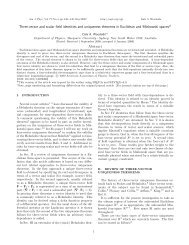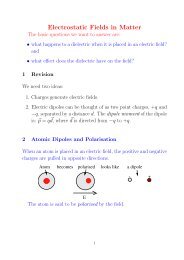Chapter 8 Vector Spaces in Quantum Mechanics
Chapter 8 Vector Spaces in Quantum Mechanics
Chapter 8 Vector Spaces in Quantum Mechanics
Create successful ePaper yourself
Turn your PDF publications into a flip-book with our unique Google optimized e-Paper software.
<strong>Chapter</strong> 8 <strong>Vector</strong> <strong>Spaces</strong> <strong>in</strong> <strong>Quantum</strong> <strong>Mechanics</strong> 79i.e. they have unit length, hence they are known as unit vectors, andû 1 · û 2 = 0 (8.4)i.e. they are orthogonal. This pair of vectors û 1 and û 2 is said to be orthonormal. Asbefore, they form a basis <strong>in</strong> that multiples of each vector can be added together <strong>in</strong> thefashion illustrated <strong>in</strong> Fig. (8.1) to form another vector. Conversely, any vector v can beexpressed us<strong>in</strong>g appropriate values for the components of v, i.e.v = aû 1 + bû 2 . (8.5)The components a and b, which represent ‘how much’ of the vector v is made up of thevectors û 1 and û 2 are given bya = û 1 · v and b = û 2 · v (8.6)A well known example of a vector expressed as a l<strong>in</strong>ear comb<strong>in</strong>ation of a pair of unitvectors is given by the position vector r written with respect to the unit vectors î and ĵ:r = xî + yĵ. (8.7)Once aga<strong>in</strong>, if we allow for the possibility of complex vectors, then the def<strong>in</strong>ition of the<strong>in</strong>ner product is changed to allow for this. Thus the <strong>in</strong>ner product of two vectors v 1 andv 2 is now v ∗ 1 · v 2, and orthonormal vectors satisfyu ∗ 1 · u 1 = u ∗ 2 · u 2 = 1u ∗ 1 · u 2 = u ∗ 2 · u 1 = 0.(8.8)Complex basis vectors are not exotic mathematical entities. A simple example is3i + 4iju 1 =54i − 3iju 2 =5(8.9)though it is true to say that they are not often encountered <strong>in</strong> mechanics, except at an advancedlevel, but are, as we shall see, rout<strong>in</strong>ely found <strong>in</strong> quantum mechanics. Because ofthat, it is convenient to <strong>in</strong>troduce a new notation for <strong>in</strong>ner product (one that is commonlyused <strong>in</strong> pure mathematics) which is to write the <strong>in</strong>ner product of two vectors v 1 and v 2 as(v 1 , v 2 ), so that we would have here(v 1 , v 2 ) = v ∗ 1 · v 2. (8.10)The value of this notation is simply that it is more general and does not tie us to the geometricalnotion of <strong>in</strong>ner product that we are used to us<strong>in</strong>g with position vectors, velocityvectors and the like.8.2 Sp<strong>in</strong> Half <strong>Quantum</strong> States as <strong>Vector</strong>sWe now need to exam<strong>in</strong>e the way <strong>in</strong> which the quantum states for a sp<strong>in</strong> half system can beseen to fit <strong>in</strong> with the idea of be<strong>in</strong>g considered as vectors. To see how this comes about, we
















